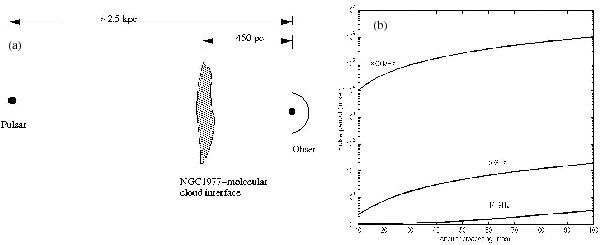Fig. 1

a) Schematic showing the scattering geometry. The H ii region-molecular cloud interface (scattering screen) is located at ~450 pc from the observer and the distance to the compact source is ≥2.5 kpc. b) The expected pulse broadening for three frequencies (330 MHz, 5 and 14 GHz) is shown in the pulsar period-angular broadening parameter space. The curves are the locus of points for pulse broadening equal to the pulsar period. For each frequency the parameter space above the curve can be probed by the pulsar search observation. The pulse broadening estimation includes contribution from an assumed intrinsic duty cycle of 10% of the pulsar period and broadening due to DM. For these calculation, the smallest pulsar period is taken as 1 ms. The range of angular broadening is constrained by observations between 10 and 100 mas. For all frequencies ≲14 GHz, the pulse broadening is dominated by scattering. At 14 GHz, for angular broadening ≲60 mas, the pulse broadening is limited by the assumed intrinsic duty cycle.
Current usage metrics show cumulative count of Article Views (full-text article views including HTML views, PDF and ePub downloads, according to the available data) and Abstracts Views on Vision4Press platform.
Data correspond to usage on the plateform after 2015. The current usage metrics is available 48-96 hours after online publication and is updated daily on week days.
Initial download of the metrics may take a while.


